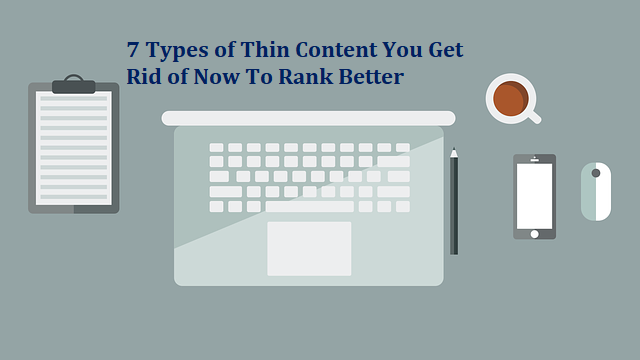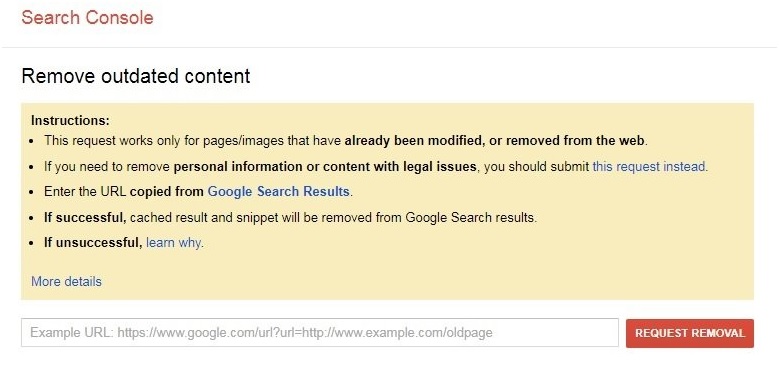What is Thin content or Shallow content?
As the name tells, it is the content with a low or null value to the readers.
A quick example – 404-page error: When a user hits the 404 pages he finds nothing and immediately leaves the site. Eventually, that leads to low bounce rate and wastage of crawl budget, both are bad signs for your website SEO.

Why thin content is bad for SEO?
Because it does not answer the user intent, either because the content is not accurate, not relevant, and incomplete or it doesn’t match what you have promised through the page title and meta description.
You know how Google is setting standards for publishers to show the best content to its search users.
Now think if your blog has thin content somehow, how do you think Google is going to make you rank? And how quickly it could damage your branding?
Thin content can destroy your traffic and sales gradually. As an online business owner, you don’t want that to happen. So better to find thin content on your website and fix it as soon as you can. Let’s talk more about it.
What are the common thin content types?
- 404 pages
- Pages with less word count (Say less than 500)
- Copied or duplicate content
- Pages with too many affiliates link and yet no great value
- Category pages
- Canonical pages
- Pages with no value
Let’s discuss each in detail and find a way to get rid of it.
1. 404-page error
In this case, you are looking for the pages that earlier had content and now deleted. But, still, those page URLs are appearing on Google.
How to find 404-page errors?
Go to Google and search for ‘site:www.yourwebsitename.com’
In my case, I searched for ‘site:nettyfeed.com’

In my case, I have 400 results with my URL.
You will need to visit all those 400 pages and make a note of all the 404 error pages into an excel file.
If you’re a blogger, this solution is simple. If you’re a big eCommerce site owner or have lots of pages, then you can take the help of premium tools like DrLinkCheck to fetch the 404 URLs of your website.
How to fix 404-page errors for permanently?
- List all the URLs into an excel file.
- Go to Google webmaster removal tools

- Enter one URL at a time and submit the ‘Request Removal’ to Google to remove the 404 URL from its database. It will remove in 24 hours, if the request is expired, submit again until you see ‘removed’ status on your screen.

That’s all.
2. Pages with the low-word count
Well, it’s tricky. Because you should not write an article that left your users unanswered and at the same time, unnecessarily stuffs with the words that have no value.
The optimal length of a page depends on matching the user’s search intent. You can do that with an ultimate 5000 -word article or even with 600 words, depends on the query.
Bungling up an article just to meet a definite word-count requirement is terrible for the readers and it will not help you in the SEO point of view as well.
So there is no thumb rule to write ‘x’ words all the time. Focus on your reader, create content that helps, probably with FAQ’s section and always measure the results that help you build better content in the future.
Now you must be thinking, what is the matter with pages with less word count, do they be considered as thin content?
‘How to create a page’ query can be answered within 800 words. And ‘how to create a website’ may require at least a 3000-word article.
But hey, don’t constantly write articles less than 300 words especially if you are a niche blogger unless niches like news or sports magazines. You may not feel a big impact but you would have already got hit with Google penalty.
Take away – Using Google analytics, find out the non-performing articles that have a low bounce rate, put yourself in the shoe of a reader and understand the reasons why it is not performing and optimize for better performance. Every page on your blog must have a reason.
3. Duplicate content
I am not going to talk about duplicate/copied content from scratch. We all know how vulnerable it is for our SEO. Even, Google openly tells you not to hug duplicate content in any way. Your website will not be removed completely for having duplicate content on your blog but it will not be well-ranked on search engines.
If you intentionally copy the content from others, it is a threat and not helpful for you in any way.
What if others copy your content?
Usually, Google rewards the first creator of the content. However, in a rare case, if Google fails to do that, you might not be ranked. Here is what you are advised to do in such time:
- Use plagiarism checker tools and find out who is copying your content (URL of the thief).
- Go to Google DMCA and submit a legal request to Google by submitting the details of the act.
Wait for 2 to 7 days to get rid of the issue.
So far, I have reported at least 40 times and got it resolved.
Take away: Don’t copy the content from others or get your content copied. Keep an eye open.
4. Pages with too many affiliate links with no value
There are a wide variety of factors that settle where a page is ranking on Google. According to SEO experts, having too many affiliate links with a less content weightage could hurt your site badly.
Google has already made it clear that giving the best reading experience and offering great content to the user is all it wants from the publishers. Advertising should be kept optimal, and it shouldn’t kill the user experience.
People don’t mind visiting blog posts where affiliate products are used in an attempt to make some money online. They are fine with it; after all, we all want some money to survive. However, they want some efforts from you putting in generating useful content that adds value to them.
So…If you are not ranking for a long time, I strongly recommend learning and implementing best practices to add affiliate links to your blog.
- Category pages
Yes, each category page is a collection of duplicate content. Google might fetch the excerpt of any post(s) from the main category page and display it in its results. Plus, most category pages are there with no actual content. That means no value and yet with multiple URLs that are leading to original blog posts.
Just think, how dangerous it could be, if you don’t take immediate action. Here are simple ways you can improve the value of category pages:
- Add a proper title, slug, and description
- Increase the no. of blog posts to appear on each category page
Is it possible to add a great value to a category page and make it rank on Google?
Yes. My friend, Nikola Roza has beautifully explained how you can do it. Take a look – Category pages for SEO.
6. Canonical pages
This is a culprit.
Once, for one of my websites, ranking started going down. And I learned that I installed the SSL certificate to it recently, which means I made it to HTTPS from HTTP.
Since I had no idea to use canonical tags, Google started considering it as the duplicate content. That means:
http://www.xyzwebsite.com and https://www.xyzwebsite.com have the same content and it was bad.
How to fix?
Mark the HTTPS version with a canonical tag. It means you are telling Google to consider the https version over HTTP, Simple.
7. Pages with low value
I mean the blog posts that are published long back but have no good traffic to them.
It could be of a few reasons:
- The page is not indexed: If this is the reason, install and setup RankMath SEO plugin in your WP dashboard and submit a fresh sitemap to Google search console.
- The page is indexed and no traffic
Here is what you should do in case 2:
Optimize your content with
- Long-tail keywords
- Better headings (h1, h2, h3) and titles
- Superior content than competitors
- FAQ sections
- Proper interlinking
FAQs about Thin Content
How bad is thin content for SEO?
It is too bad. You kill it first if you want to rank on Google and build a reputed brand online.
How can you avoid thin content?
Use tools like SEMrush, audit your site, find and fix the errors. That’s how you find out the mistakes.
Always thrive to grow online.
Who should care for thin content?
Bloggers and SMEs. Basically, anyone who has a website that generates bread and butter for him/her.
Can I hire someone to fix my thin content?
If you are a blogger, I want you to audit your site as mentioned above and fixed. You know your blog well than others.
If you are a business owner and have no time to do, I suggest you hire a freelancer from sites like Fiverr, Upwork, etc.
I don’t care about the SEO of my website as I mostly run paid campaigns to generate leads. So I want to ignore thin content, will that be fine?
No. Some or other day, your customers or prospects going to find your SEO errors and that is going to cost you bigger.
How to know that I’m hit by Google penalty due to thin content?
Keep an eye on your traffic and keyword rankings and be alert if there’s any big drop. As I said, always use Google analytics and SEMrush to track and measure your blog performance.
Conclusion
Most bloggers either they would underestimate thin content or don’t know about it yet. It is always good to learn about SEO mistakes and fix them on time.
It helps you rank better and early on search engines and achieve your business goals. After all, thin content is one of the dangerous things that kill your website’s reputation. So be careful and audit your website now!
Do you know any other thin content types? Please share it in the comments section.

Hey Mudassir & Vishwajeet,
First Of All, Thanks A Lot For The Quick Shout-Out. Thin contents are literally a pain and it happens when a blogger is clueless about the type of contents. I have also a few thin contents on my blog and now I am getting rid of them.
I really like the way you have presented the importance of adding valuable content on the blog.
Regards
Chayan
Hi Mudassir
Amazing post!
It always feels good when you land on a blog to read something and go back with the out of the box learnings.
This post did exactly the same to me and I am happy that I visited this blog post.
Thanks for Sharing
Amit Garg